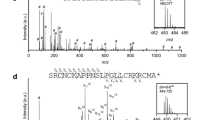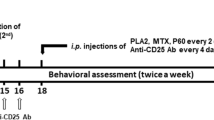Abstract
THE belief that the venom of the common honey bee, Apis mellifira, is beneficial in certain arthritic and rheumatoid conditions goes back to antiquity1. In a study of phospholi-pase-A2,3 we have fractionated nearly 1 kg of freeze-dried bee venom and tested all the fractions for anti-inflammatory activity. Preliminary experiments showed activity to be associated with the basic peptide fraction. The peptides were separated using ‘Sephadex’ G25 and G50 followed by ion-exchange chromatography using either CM ‘Sephadex’ C25 (pH 4.7) or SE ‘Sephadex’ C25 (pH 4.2).
This is a preview of subscription content, access via your institution
Access options
Subscribe to this journal
Receive 51 print issues and online access
$199.00 per year
only $3.90 per issue
Buy this article
- Purchase on Springer Link
- Instant access to full article PDF
Prices may be subject to local taxes which are calculated during checkout
Similar content being viewed by others
References
Beck, B., Bee Venom Therapy (Appleton-Century, New York, 1935).
Shipolini, R. A., Callewaert, G. L., Cottrell, R. C., Doonan, S., and Vernon, C. A., Eur. J. Biochem., 20, 459 (1971).
Shipolini, R. A., Callewaert, G. L., Cottrell, R. C., and Vernon, C. A., FEBS Lett., 1, 39 (1971).
Winter, C. A., Risley, E. A., and Nuss, G. W., Proc. Soc. expl. Biol. Med., 111, 544 (1962).
Billingham, M. E. J., Robinson, B. V., and Robson, J. M., Br. J. Pharmac., 35, 543 (1969).
Breithaupt, H., and Habermann, E., Arch. expl. Path. Pharmak., 261, 252 (1968).
Von-Haux, P., Hoppe-Seyler's Z. physiol. Chem., 350, 536 (1969).
Vernon, C. A., Hanson, Jennifer M., and Brimblecombe, R. W., British Patent No. 1314823 (1969).
Garlick, D. G., Aust. J. expl. Biol. med. Sci., 43, 671 (1965).
Hanson, Jennifer M., Morley, J., and Soria, C., Br. J. Pharmac., 46, 537 (1972).
Chayen, J., Bitensky, L., Butcher, R. G., Poulter, L. W., and Ubhi, G. S., Br. J. Derm., 82, Supplement 6, 62 (1970).
Chayen, J., Bitensky, L., and Ubhi, G. S., Beitr. path. Anat., 147, 6 (1972).
Newbould, B. B., Br. J. Pharmac., 21, 127 (1963).
Habermann, E., and Reiz, K. G., Biochem. Z., 343, 192 (1965).
Habermann, E., and Jentsch, J., Hoppe-Seyler's Z. physiol. Chem., 348, 37 (1967).
Habermann, E., Ergebn. Physiol., 60, 220 (1968).
Habermann, E., Recent Advances in the Pharmacology of Toxins, 53 (Pergamon Press, London, 1963).
Hammeral, A. M., and Pitchler, O., Med. Clins. N. Am., 55, 2015 (1960).
Author information
Authors and Affiliations
Rights and permissions
About this article
Cite this article
BILLINGHAM, M., MORLEY, J., HANSON, J. et al. An Anti-Inflammatory Peptide from Bee Venom. Nature 245, 163–164 (1973). https://doi.org/10.1038/245163a0
Received:
Revised:
Issue Date:
DOI: https://doi.org/10.1038/245163a0
This article is cited by
-
COVID-19 pandemic: impacts on bees, beekeeping, and potential role of bee products as antiviral agents and immune enhancers
Environmental Science and Pollution Research (2022)
-
Hepatoprotective activity of melittin on isoniazid- and rifampicin-induced liver injuries in male albino rats
BMC Pharmacology and Toxicology (2021)
-
Detoxification of Bee Venom Increases Its Anti-inflammatory Activity and Decreases Its Cytotoxicity and Allergenic Activity
Applied Biochemistry and Biotechnology (2021)
-
Antiinflammatory peptides: current knowledge and promising prospects
Inflammation Research (2019)
-
Bee venom phospholipase A2 suppression of experimental autoimmune encephalomyelitis is dependent on its enzymatic activity
Molecular & Cellular Toxicology (2019)
Comments
By submitting a comment you agree to abide by our Terms and Community Guidelines. If you find something abusive or that does not comply with our terms or guidelines please flag it as inappropriate.



